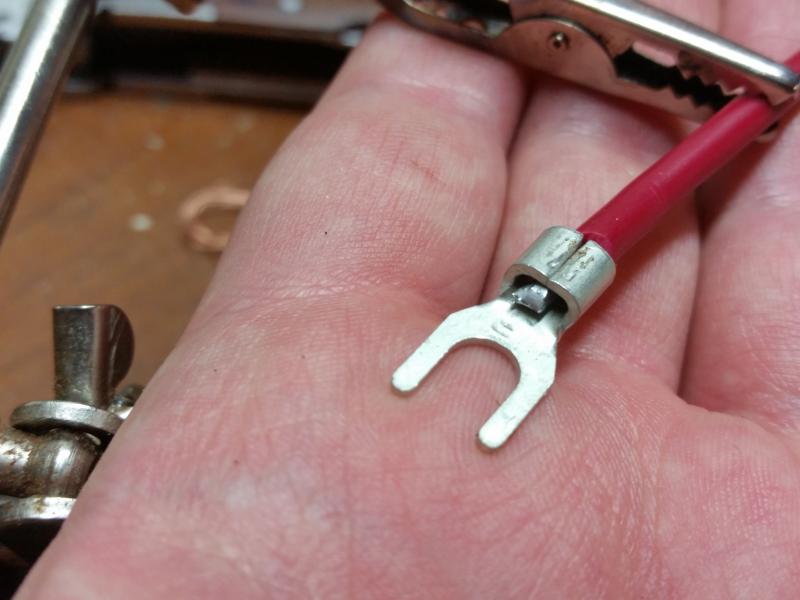| PM | Quote | Reply | Full Topic |
Old Bastard !
Joined: Fri Dec 22nd, 2017
Location: California USA
Posts: 2108
Status:
Offline
Reputation: 











Reputation Points: $user_rep
I.e. the picture:

IMO..., When looking at the crimped lug you can see the actual contact point is to left side about 1/2 the length of the crimped area, not a lot of contact.
All lugs should be crimped with the wire unsoldered, the wire can be twisted, not super tight, but have a good mechanical bond before adding solder, which isn't a bad idea, IF cleaned properly after soldering, which would mean cleaning with Alcohol, not the booze. Residue after soldering can corrode, even with Heat- Shrink, causing a bad connection.
This picture shows a good solder flow in the wire BUT minimal wire to Lug Contact, which will create a resistance, even after soldering; IF this Lug were to heat up, from a shorted condition, and the solder melting, the wire could slip out and if hot, could create a fire.
Always, crimp wire in lugs before soldering, get a good mechanical bond, pull on the lug to see if it stays on the wire, THEN... add solder to the connection as a bonding assist.
Note: A solid mechanical bond, (crimped properly, will allow the most wire to Lug contact and the most conductivity in the connection), and using heat shrink with Adhesive on the inside, will last and be water-proof... !
Also, double check your Lug Crimpers, there should be a Nub on one side, that Nub should go against the solid portion of the Lug, not the split, and impress inward, spreading the wires within the indent without separating the split, allowing full contact, so using the correct crimpers make a big difference too.
When using Heat Shrink in an automotive circuit, you should strive for a water-proof connection when ever possible, use the Heat Shrink type with adhesive on the inside, and make sure once the Heat Shrink is shrunk, you can see the adhesive coming out of the end of the Heat Shrink, this makes it water-proof.
These steps make for a more secure, water-proof connection with less worries about corrosion and a bad connection.
So where so I get off stepping in here and saying things about someone else hard word at a writeup... I know, what an A-Hole !
I base my comment on a long-term Quality Assurance/Control Methods Writing, within many Military/Government Facilities, and on a longing of doing things so they do not have to be "EVER done over". I love my Ranger and all of the info on these Ranger Sites but I an not trying in any way to cause a problem of call anyone wrong... everyone has THEIR way !
I agree with "TheArticWolf1911" is his methods, I do things the same way except for his crimping, and believe me everyone definitely has their own way of crimping.
My apologies to TheArticWolf1911, if there is any conflict, it wasn't meant to be.
Ltr
Last edited on Thu Apr 11th, 2019 06:10 pm by Scrambler82
____________________
Ltr,
2003 EDGE, Std Cab, Steppie, E4 Red, 5sp, 4x
5" SuperLift, 33" x 12.50 x 15"
Hurst Shifter
Mod'd Backrack to fit Steppie
Front and Rear Bumpers by Custom 4x4 Fabrication, OK; now Mike's Welding and Fabrication.
Working on more Mods, just need more time, longer days would work !